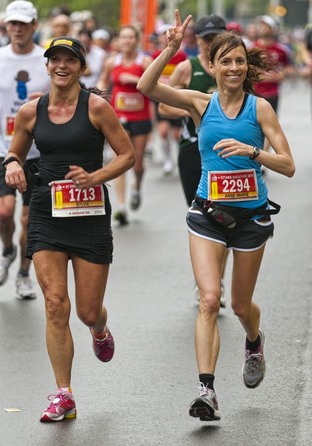How many eggs should I eat?

Did you know that eggs may promote good health. Maybe you did. But, do you know how many you should eat? Probably not, because nobody really knows. In recent years we have somehow become a little bit afraid of eating eggs. We have been warned that they may be harmful because they contain so much cholesterol. Everybody knows that high blood cholesterol has been associated with heart disease.
General recommendations usually state that our daily intake of cholesterol should not be more than 300 milligrams. One egg probably contains somewhere between 180 - 200 milligrams of cholesterol. This cholesterol is mainly found in the yolk. Thus, it is clear that you cannot eat many eggs in a week if you are going to obey to the above recommendation.
However, recently it has become clear that cholesterol in food does not to affect blood cholesterol as much as previously thought. Only a small fraction of the cholesterol we eat goes into the blood stream. The liver produces cholesterol. It´s an important substance for the body. Cholesterol is an integral part of cell membranes and many hormones. Some experts have said that if we eat little cholesterol, the liver will just produce more and if we eat much cholesterol, the liver will just produce less. Therefore, it may not matter at all how much cholesterol we eat. Although this hypothesis is still debated, todays evidence suggests that moderate consumption of eggs will not significantly affect your blood cholesterol. There is no evidence available at all suggesting that eating eggs will increase the risk of heart disease.
Many nutritional experts today claim that eating saturated fat is much more likely to raise your blood cholesterol than eating cholesterol. Eggs do contain some saturated fats but they are also rich in healthy monounsaturated and polyunsaturated fats. It may however matter for your health how you prepare your eggs and what you choose to eat with them. Boiling the eggs is healthy, simple and easy. You don´t have to fry the eggs in fat. Stay away from the bacon, at least if you are trying to avoid saturated fats or lower your cholesterol.
Eggs have a high nutritional value. They are rich in protein, healthy fatty acids and vitamins. They contain a lot of vitamin D. They have no carbohydrates at all. Eggs are rich in a substance called choline. Recent research indicates that choline deficiency may be quite common. Choline may help reducing inflammation. One egg contains 25% of our daily need for choline.
Eggs are a relatively satiating food. Eggs may help you lose weight, partly because they will help you stay away from unhealthy carbohydrates.
My conclusion is that eggs are a healthy food choice and a good source of nutrients. They are satiating and a good source of energy. One egg a day is fine and there is no evidence that it will do you any harm.
Do you prefer aisle or window?

Did you know that it may matter for your health whether you choose an aisle or a window seat on long flights? It can actually be more dangerous for you to sit in the window seat. This has nothing to do with the window itself, space radiation or temperature which might be the first things that pop to your mind.
During long flights blood clots may develop in the deep veins of the limb, a phenomenon known as DVT (deep vein thrombosis). It has been proposed that the risk of DVT may be related to less space on flights and therefore this phenomenon has commonly been nicknamed "economy class syndrome". These blood clots me be hazardous as they can float to the lungs and get stuck in their arteries (pulmonary embolism).
Sitting in a window seat is a risk factor for DVT, the American College of Chest Physicians (ACCP) warn in their new advisory, regardless of whether it's in economy or first class.
Various risk factors for blood clots in deep veins during flight have been identified. Immobility seems to the biggest risk factor. If you sit in a window seat you are more unlikely to stand up and move around than if you you sit by the aisle. If you sit in the aisle seat you can stand up whenever you like without annoying anyone. If you sit by the window, the person next you you might be in the middle of meal or in deep sleep when are going to do your hourly leg exercise, so you will probably skip it.
"DVT risk has nothing to do with economy class," said Dr. Gordon H. Guyatt, chair of the ACCP panel that drafted the new guidelines. "Really, the evidence is that actually where you sit isn't really an issue. It's how much you move around. And if you're in a window seat you are probably more willing to sit for long periods of time being uncomfortable because you are reluctant to make anybody else move to let you out." These instructions are published in the latest issue of the journal Chest, and you can view them here.
Still, "the first thing to say is that if you are a healthy person you should not really worry about DVT because your risk -- even on a long-term flight -- is considerably less than one in a thousand," said Guyatt, who is also professor in the department of clinical epidemiology and biostatistics at McMaster University in Hamilton, Ontario, Canada. "So these guidelines are for those who have more than a normal risk. For those who have had a clot before, or an abnormality of their coagulation system, or disability that affects mobility. Or if you are obese or have active cancer." Others who are at risk are older people, pregnant women, women who take estrogen replacement therapy, such as oral contraceptives and individuals who have recently undergone surgery.
Apart from seating considerations, the guidelines also suggest that people on flights lasting six or more hours move about frequently and stretch their calf muscles.
Higher-risk individuals should also wear graduated compression stockings that stretch below the knee. Guyatt said it "would be crazy" for passengers at normal risk to wear such stockings, and the ACCP guidelines specifically argue against their use by healthy passengers.
The guidelines also generally discourage the taking of aspirin and/or anticoagulant medications for the specific intent of lowering DVT risk. That said, those at very high risk are encouraged to consult their doctors in order to weigh the pros and cons of such drugs. Obviously it is not advisable to take a sleeping pill and curl up in your seat for the whole voyage.
The weakness of women...

Did yo know that women were not allowed to run marathon at the Olympics until the 1984 games in Los Angeles. Prior to the 1960´s women were banned from running any race longer than 800 meters, and they could not officially participate in marathon competitions until 1970. The sports authorities believed that they could harm themselves and that the woman body was unsuitable for distance running.
Women had been excluded from track and field competition altogether until 1928, when the longest race was the 800 meters. Despite a world record by winner Lina Radke of Germany, many of the competitors had not properly prepared for the race and several collapsed in exhaustion. This led Olympic organizers to consider the race too strenuous for women.
Winner of the first women´s marathon at the í Los Angeles Olympics in 1984 was Joan Benoit from the United States. She was then 27 years old. Her time, 02:24:52, would have won 11 of the previous 20 men´s Olympic marathons.
In March 1984, Benoit injured her knee severely during a 20 mile training run, forcing her to undergo arthroscopic knee surgery just 17 days before the United States Olympic Women's Marathon Trials were scheduled. However, she recovered from the surgery much quicker than expected, and showed up at the trials as the woman to beat. She beat runner-up Julie Brown, only by 30 seconds, winning in 2:31:04. Three months later, she competed in the 1984 Summer Olympics in Los Angeles and won the first Olympic Women's Marathon hundred meters ahead of Grete Waitz, Rosa Mota, and Ingrid Kristiansen, all considered legends in their own rights
The fight for women being allowed to compete in long distance running had been going on for some time. Roberta Gibb hid behind a bush at the start of the Boston Marathon, sneaking into the field and finishing the race in an unofficial time of 3:21:25. She was the first woman known to complete the arduous Boston course. Gibb had been inspired to run by the return of her race entry with a note saying that women were not physically capable of running a marathon.
This is how Roberta Gibb describes her experience:
"I took the bus back from San Diego, curled up in the seat for three nights and four days, eating only a bag of apples and bus station chili and arrived the day before the race at my parents’ house in Winchester. I ate a huge roast beef dinner and apple pie. The next day my mother drove me to the start in Hopkinton and dropped me off. I ran up and down a couple of miles to warm up, and then I hid in the bushes near the start.
When the gun went off I jumped into the pack. I had no idea what kind of reception I’d get. I was afraid the police would arrest me and that the spectators might boo and hiss. I was afraid that if the officials saw I was a woman they’d throw me out. I was all alone. I knew the most important thing was to prevent anyone from stopping me, so I wore a blue sweatshirt with the hood pulled up and my brother’s Bermuda shorts tied up with a string, over my black, tank-topped bathing suit.
Very quickly, the men behind me, studying my anatomy, figured out that I was a woman, and to my great relief, they were supportive and friendly. They could have shouldered me off the course, but instead they said, “It’s a free road. We won’t let anyone throw you out.” So contrary to what some people think, it was not a men-versus-women confrontation. The men were glad that I was running. With this encouragement, I took off the hot, heavy sweatshirt, and then everyone could see that I was a woman. A cheer went up from the crowd when they saw a woman was running."
